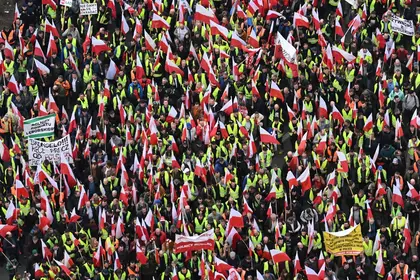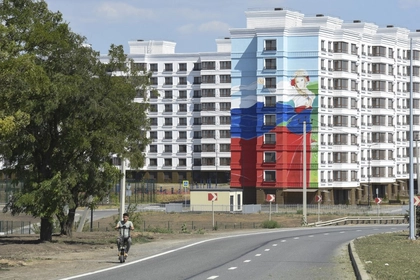Recently there have been voices saying that support for pro-Russian powers is increasing in the EU – especially in Poland. We have all seen disturbing incidents as well as disgraceful pro-Russian banners at the farmer protests on Poland’s border with Ukraine.
But as soon as one scratches the surface, a completely different picture emerges. What we are seeing is a mass movement of Polish farmers dissatisfied with the grain price drop that occurred during the previous Polish government.
JOIN US ON TELEGRAM
Follow our coverage of the war on the @Kyivpost_official.
In the meantime, the Russian disinformation machine has managed to successfully jump on this bandwagon, sending people, media and money in order to stir the crisis in their favor.
Some gullible journalists are buying it, believing that all of a sudden an anti-Ukrainian power is at play in Polish politics. But nothing can be further from the truth. Instead, we have the deployment of the usual smoke and mirrors, lies and propaganda, all skillfully managed by Moscow operatives.
Let’s unpack it step by step.
Farmers needed to identify the source of the problem, and Kyiv and Brussels were obvious targets
What do the Polish farmers want?
Polish farmers didn’t take to the streets for no reason. In 2023 the prices they sold grain for were below their production costs. And they had done everything by the book: they had sown their fields, spread fertilizers, fought pests, harvested it all, and suddenly no one wants to buy it for a fair price.
At the same time, Polish warehouses saw Ukrainian grain being brought in. Farmers needed to identify the source of the problem, and Kyiv and Brussels were obvious targets.

Azerbaijan-Brokered Deal to Keep Gas Flowing to EU via Ukraine Fails
Back in June 2022, the European Commission suspended customs duties on Ukrainian food to help the war effort. The argument was simple: Ukraine must export its grain because it needs money for armaments, and since Russia is blocking the Black Sea ports, the wheat, corn and rapeseed must be transported by rail and truck through neighboring countries. Moreover, Arab countries need this grain very much, so the decision was made.
The former Polish government of the Law and Justice (PiS) party eagerly supported this idea. Even the opposition parties joined in. Everyone wanted to help Ukraine. So as time went by, Ukrainian grain started flowing in. But no effective security measures had been introduced to ensure that it proceed to the ports instead of staying in Poland. So it stayed and began accumulating in Polish warehouses, eagerly bought by Polish firms due to its lower price.
With all this new, cheap grain on the market, the price of Polish grain begun to plummet. And the price of grain hasn’t gone back up, as promised.
The real reason for the grain price drop
Although imports from Ukraine have lowered sales prices in Poland and clogged some grain warehouses, they are not the main culprit of the price drop. The total volume of Ukrainian grain that made its way to Polish warehouses accounted for less than 10 percent of the total Polish annual production. The angry farmers blocking the border crossings will not tell you this, but in fact, the biggest culprit is somewhere else.
It is Moscow, not Kyiv, that has successfully spurred a decline in grain prices on international commodities exchanges. Russia is the world’s largest wheat exporter. And as it just so happened, Russia has had a great harvest two years in a row. After occupying parts of Ukraine, it also stole millions of tons of Ukrainian grain stored there. Since it needs money to wage war, it dumped its enormous surplus on the world market far below usual market levels. And that is why wheat on world markets today costs not $350 per metric ton, but $210.
Yes, it is even cheaper in Poland, because Polish farmers sell it for $163 – and this is the result of the inflow of Ukrainian wheat. But even if not a single grain came from Ukraine, the price would not return to $350.
How is Russia taking advantage of the situation?
Where did the champagne corks pop? Obviously in the Kremlin. Nobody will find it surprising that Moscow uses elections, protests and social unrest as tools of its hybrid warfare. Within the last few years, there have been many reports about how Russia meddles in the domestic and bilateral affairs of third countries. Moldova, Slovakia, the Baltic states – wherever there is any pro-Russian sentiment, Kremlin operatives come in with cash, expertise and a plan.
In Poland, however, things are totally different. Not only is any form of pro-Russian sentiment non-existent in the mainstream of politics, but the society as whole is rooted in a deep distrust of Moscow. So if Russia can’t influence Polish society, the main tool left is trying to affect bilateral relations between Warsaw and Kyiv. And the tensions between the government and farmers couldn’t have come at a better moment.
“Russian propaganda intensively uses incidents occurring during farmers’ protests in Poland to disrupt Polish-Ukrainian relations and negatively affect the image of the Republic of Poland in the West,” claims a Polish agency specializing in fighting disinformation.
Among the protesters who demand to secure their professional interests, there are groups of individuals with no factual arguments but alleged ties with Russia. The people you can find in this group are far-right nationalist Rafał Mekler and Sławomir Zakrzewski, who is known for his ties with the Russian embassy in Warsaw, among others. Freedom of speech and assembly is not limited in Poland, as long as it adheres to the law. This also applies to such events.
What we need to do to counteract Russian meddling
After Polish parliamentary elections on Oct. 15, 2023, the ruling coalition decided to continue the path of strong support for Ukraine taken by the former PiS government. Foreign relations are not a solid state but a process – Donald Tusk’s cabinet inherited the problems too.
Nevertheless, the issues mentioned thus far won’t worsen bilateral relations. Some conflicts of interests just can’t outshine things that unite the countries. Following-up on farmers protests, alongside the criticism over new EU regulations, we can all see some pro-Russian and anti-Ukrainian slogans. Russia deliberately fuels it with anti-Ukrainian narratives and uses the protests to weaken relations between Warsaw and Kyiv, and between their societies, which makes it another front line in Russia’s hybrid war against the West.
With regard to Polish support for Ukraine, the majority of the moods from right to left are enthusiastic, and anti-Ukrainian narratives face huge criticism, but there’s no denying that there’s a downward trend.
There’s no big change when it comes to the Polish political class and public debate. The radical voices that have been seen at the farmers protests are not a part of Poland’s political mainstream. However, it’s impossible to hide the fact that this is a domestic problem for Tusk’s cabinet. Especially in an ongoing election campaign, as Poles will go to ballot boxes and vote for local authorities in the beginning of April.
Further Polish support for Ukraine is not in dispute. Yet such a situation calls for mutual understanding, and joint solutions are necessary.
After the Polish parliamentary elections on Oct. 15, 2023, the new liberal-left government decided to continue on the path of strong support for Ukraine. However, one must be careful ensure that the anti-Ukrainian sentiment does not spill out from what is still a niche, into the big arena.
Michał Kujawski is a Warsaw-based journalist focused on CEE region, former Head of Current Affairs at TVP World.
The views expressed in this opinion article are the author’s and not necessarily those of Kyiv Post.
You can also highlight the text and press Ctrl + Enter






